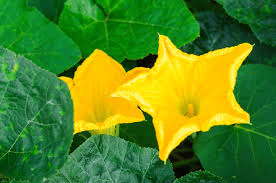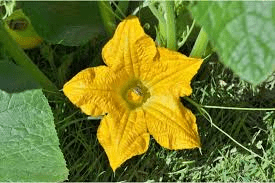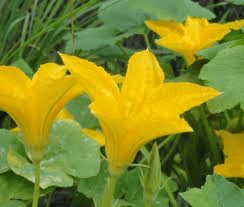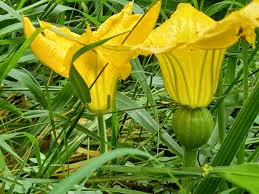Pumpkin flowers are large, trumpet-shaped blooms that typically appear in shades of yellow or orange. These flowers emerge from the pumpkin vine, which is a sprawling, fast-growing plant.
The flowers are unisexual, meaning there are separate male and female flowers on the same plant. This separation is vital for the process of pollination, which is necessary for the development of pumpkin fruits.
Male pumpkin flowers are the first to appear on the plant. They grow on long, thin stems and can be identified by their stamens, which are the pollen-producing parts of the flower. Each stamen is covered in a fine, yellow powdery substance known as pollen.
Male flowers are produced in abundance and are usually located at the ends of the vines, extending outward to attract pollinators like bees. These pollinators are essential for transferring pollen from the male flowers to the female flowers.
Female pumpkin flowers, on the other hand, are slightly different in appearance. They grow closer to the base of the plant and can be distinguished by their swollen base, which is the ovary.
This ovary will develop into a pumpkin if fertilization occurs. Female flowers have a pistil, which consists of a stigma, style, and ovary. The stigma is sticky and is designed to catch pollen. Once pollination occurs, the pollen travels down the style to fertilize the ovules within the ovary, leading to fruit development.
Pollination is a critical process for pumpkin plants. It typically occurs through insect activity, primarily bees. When bees visit the male flowers to collect nectar and pollen, they inadvertently pick up pollen on their bodies. As they move to female flowers in search of more nectar, they transfer this pollen, enabling fertilization.
In the absence of adequate pollination, the female flowers may not develop into fruits, which can significantly impact pumpkin yields.
Beyond their biological importance, pumpkin flowers are also edible and have been used in various culinary traditions. They are often stuffed, battered, and fried or used in soups, salads, and other dishes. The flowers have a delicate, slightly sweet flavor and a tender texture, making them a versatile ingredient in the kitchen.
When harvesting pumpkin flowers for cooking, it is common practice to pick the male flowers, as this allows the female flowers to remain on the plant for fruit development.
Nutritionally, pumpkin flowers are low in calories but rich in vitamins and minerals. They provide a good source of vitamins A and C, as well as folate, calcium, and iron. These nutrients contribute to various health benefits, including immune support, bone health, and overall wellness.
In summary, pumpkin flowers are an essential part of the pumpkin plant’s life cycle, playing a vital role in reproduction and fruit production.
Their striking appearance and dual roles in both biology and cuisine make them a fascinating subject of study. Whether appreciated for their contribution to pumpkin harvests or enjoyed as a unique ingredient in culinary creations, pumpkin flowers offer a rich blend of beauty, function, and flavor.
The Economic Importance and Uses of Pumpkin Flowers

1. Food Ingredient: Pumpkin flowers are edible and are used in various cuisines worldwide. They can be fried, stuffed, or added to soups and salads. For example, stuffed pumpkin flowers are a popular dish in Italian cuisine.
2. Nutritional Value: Pumpkin flowers are rich in vitamins A, C, and E, as well as minerals like calcium and iron, which contribute to a balanced diet and promote good health.
3. Traditional Medicine: In some cultures, pumpkin flowers are used in traditional medicine to treat ailments such as inflammation, urinary infections, and diabetes.
4. Agriculture: Growing pumpkin flowers can benefit farmers as they can be sold in local markets, providing an additional source of income.
5. Animal Feed: Pumpkin flowers can be used as a nutritious feed for livestock, such as chickens and rabbits, enhancing their diet and growth.
6. Culinary Delicacy: Pumpkin flowers are considered a delicacy in many parts of the world, including Mexico and India, where they are used in traditional dishes.
7. Eco-Friendly Agriculture: Pumpkin plants can improve soil health and reduce the need for chemical fertilizers, promoting sustainable agriculture.
8. Pollination Support: Pumpkin flowers attract pollinators like bees, which help in the pollination of other crops in the vicinity.
9. Culinary Innovation: Chefs use pumpkin flowers to create innovative and visually appealing dishes, enhancing the dining experience.
10. Export Potential: Pumpkin flowers have a market in international gourmet food markets, providing export opportunities for growers.
11. Income Diversification: By growing and selling pumpkin flowers, farmers can diversify their income sources and reduce financial risk.
12. Seasonal Employment: Harvesting and processing pumpkin flowers can create seasonal job opportunities in rural areas.
13. Home Gardening: Pumpkin flowers are easy to grow in home gardens, providing fresh and healthy produce for households.
14. Edible Landscaping: Pumpkin flowers can be used in edible landscaping, combining aesthetic appeal with food production.
15. Organic Farming: Pumpkin flowers can be grown organically, meeting the demand for organic products.
16. Agro-Tourism: Farms that grow pumpkin flowers can attract tourists interested in agro-tourism, generating additional revenue.
17. Culinary Education: Cooking schools and culinary programs use pumpkin flowers to teach students about unique ingredients and cooking techniques.
18. Local Cuisine Promotion: Promoting the use of pumpkin flowers in local cuisine can enhance cultural heritage and attract food enthusiasts.
Read Also: The Variety of Fish Body Shapes
The Products and By-products That Can Be Derived From Pumpkin Flowers

1. Fresh Flowers: Fresh pumpkin flowers can be sold directly in markets for culinary use. Example: Fresh flowers sold in farmer’s markets.
2. Dried Flowers: Pumpkin flowers can be dried and used as a garnish or ingredient in various dishes. Example: Dried pumpkin flower powder.
3. Flower Powder: Dried pumpkin flowers can be ground into a powder and used as a nutritional supplement. Example: Pumpkin flower powder in smoothies.
4. Flower Oil: Pumpkin flower oil can be extracted and used in cosmetics and cooking. Example: Pumpkin flower-infused oil.
5. Herbal Teas: Dried pumpkin flowers can be used to make herbal teas with health benefits. Example: Pumpkin flower tea.
6. Flower Extract: Pumpkin flower extract can be used in supplements and skincare products. Example: Pumpkin flower extract capsules.
7. Flower Syrup: Pumpkin flower syrup can be made and used as a sweetener or flavoring agent. Example: Pumpkin flower syrup in desserts.
8. Flower Paste: Pumpkin flowers can be blended into a paste for use in cooking. Example: Pumpkin flower paste in sauces.
9. Cosmetic Products: Pumpkin flower extracts can be used in lotions, creams, and other cosmetic products. Example: Pumpkin flower face cream.
10. Natural Dye: Pumpkin flowers can be used to produce natural dyes for fabrics and crafts. Example: Pumpkin flower dye for textiles.
11. Animal Feed Supplements: Dried and powdered pumpkin flowers can be added to animal feed for nutritional benefits. Example: Feed supplement for poultry.
12. Fertilizer: Composting pumpkin flowers can create a nutrient-rich fertilizer for plants. Example: Organic fertilizer from composted flowers.
13. Biofuel: Pumpkin flower waste can be processed into biofuel. Example: Biogas production from flower waste.
14. Flavoring Agents: Extracts from pumpkin flowers can be used to flavor foods and beverages. Example: Pumpkin flower flavoring in beverages.
15. Nutritional Supplements: Pumpkin flower powder can be encapsulated and sold as a dietary supplement. Example: Pumpkin flower supplement capsules.
16. Antioxidant Source: Pumpkin flowers contain antioxidants and can be used in health products. Example: Antioxidant-rich pumpkin flower extract.
17. Culinary Decor: Pumpkin flowers can be used to decorate dishes, enhancing visual appeal. Example: Pumpkin flower garnish on salads.
Read Also: Fish Biology: Anatomy, Physiology, Embryology and Endocrinology
Frequently Asked Questions (FAQ’s) About Pumpkin Flowers

1. What are pumpkin flowers?
Pumpkin flowers are the blossoms of the pumpkin plant, which are edible and used in various culinary dishes.
2. Are pumpkin flowers edible?
Yes, pumpkin flowers are edible and can be used in a variety of dishes, such as soups, salads, and fried foods.
3. How do you prepare pumpkin flowers for cooking?
Pumpkin flowers should be washed thoroughly, and the stamen should be removed before cooking.
4. What do pumpkin flowers taste like?
Pumpkin flowers have a mild, slightly sweet flavor and a delicate texture.
5. Are there any health benefits to eating pumpkin flowers?
Yes, pumpkin flowers are rich in vitamins A, C, and E, and contain important minerals like calcium and iron.
6. Can pumpkin flowers be eaten raw?
Pumpkin flowers can be eaten raw, but they are more commonly cooked to enhance their flavor and texture.
7. How do you store pumpkin flowers?
Fresh pumpkin flowers should be stored in the refrigerator and used within a few days. Dried flowers can be stored in an airtight container.
8. Are pumpkin flowers used in traditional medicine?
Yes, in some cultures, pumpkin flowers are used to treat inflammation, urinary infections, and diabetes.
9. Can pumpkin flowers be used in organic farming?
Yes, pumpkin flowers can be grown organically and are often used in sustainable agricultural practices.
10. What dishes can I make with pumpkin flowers?
You can make a variety of dishes with pumpkin flowers, including stuffed flowers, pumpkin flower fritters, soups, and salads.

